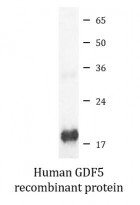ARG70100
Human GDF5 recombinant protein (Active) (His-tagged, C-ter)
Human GDF5 recombinant protein (Active) (His-tagged, C-ter) for SDS-PAGE
Overview
| Product Description | E. coli expressed, His-tagged (C-ter) Active Human GDF5 recombinant protein |
|---|---|
| Tested Application | SDS-PAGE |
| Target Name | GDF5 |
| Species | Human |
| A.A. Sequence | Ala382 - Arg501 |
| Expression System | E. coli |
| Activity | Active |
| Activity Note | Determined by its ability to induce alkaline phosphatase production by ATDC5 cells. The ED50 for this effect is < 14 ng/mL. |
| Alternate Names | Cdmp-1; GDF-5; Growth/differentiation factor 5; Bone morphogenetic protein 14; brp; BMP-14; bp |
Properties
| Form | Powder |
|---|---|
| Purification Note | Endotoxin level is less than 0.1 EU/µg of the protein, as determined by the LAL test. |
| Purity | > 98% (by SDS-PAGE) |
| Buffer | 20 mM sodium citrate and 0.2 M NaCl (pH 3.5) |
| Reconstitution | It is recommended to reconstitute the lyophilized protein in 4 mM HCl to a concentration not less than 200 μg/mL and incubate the stock solution for at least 20 min at room temperature to make sure the protein is dissolved completely. |
| Storage Instruction | For long term, lyophilized protein should be stored at -20°C or -80°C. After reconstitution, aliquot and store at -20°C or -80°C for up to one month. Storage in frost free freezers is not recommended. Avoid repeated freeze/thaw cycles. Suggest spin the vial prior to opening. |
| Note | For laboratory research only, not for drug, diagnostic or other use. |
Bioinformation
| Gene Symbol | Gdf5 |
|---|---|
| Gene Full Name | growth differentiation factor 5 |
| Function | Growth factor involved in bone and cartilage formation. During cartilage development regulates differentiation of chondrogenic tissue through two pathways. Firstly, positively regulates differentiation of chondrogenic tissue through its binding of high affinity with BMPR1B and of less affinity with BMPR1A, leading to induction of SMAD1-SMAD5-SMAD8 complex phosphorylation and then SMAD protein signaling transduction (By similarity). Secondly, negatively regulates chondrogenic differentiation through its interaction with NOG (By similarity). Required to prevent excessive muscle loss upon denervation. This function requires SMAD4 and is mediated by phosphorylated SMAD1/5/8. Binds bacterial lipopolysaccharide (LPS) and mediates LPS-induced inflammatory response, including TNF secretion by monocytes (By similarity). [UniProt] |
Images (1) Click the Picture to Zoom In






